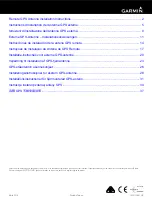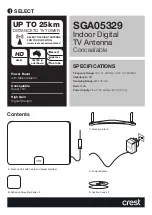
Installation
9797B-76 C/Ku-Band TXRX
4-2
WARNING:
RF Radiation Hazard - This stabilized antenna system is designed to be used with
transmit/receive equipment manufactured by others. Refer to the documentation supplied by
the manufacturer which will describe potential hazards, including exposure to RF radiation,
associated with the improper use of the transmit/receive equipment. Note that the
transmit/receive equipment will operate independently of the stabilized antenna system.
The ultimate responsibility for safety rests with the facility operator and the
individuals who work on the system.
WARNING:
RF Radiation Hazard - Prior to working on the stabilized antenna system, the
power to the
transmit/receive
equipment must be locked out and tagged.
Turning OFF
power to the Antenna Control Unit does NOT turn Transmit power output OFF.
The ultimate responsibility for safety rests with the facility operator and the
individuals who work on the system.
WARNING:
RF Radiation Hazard - When the transmit/receive system is in operation, no one
should be allowed anywhere within the radiated beam being emitted from the reflector.
The ultimate responsibility for safety rests with the facility operator and the
individuals who work on the system.
4.2.
Site Survey
The radome assembly should be installed at a location aboard ship where:
1.
The antenna has a clear line-of-sight to as much of the sky (horizon to zenith at all bearings) as is practical.
2.
Direct radiation into the antenna from ships radar, especially high power surveillance radar arrays, is
minimized. The radome should be as far away from the ships Radar as possible and should NOT be mounted
on the same plane as the ships Radar (so that it is not directly in the Radar beam path).
3.
The radome should be as far away from the ships high power short wave (MF & HF) transmitting antennas as
possible.
4.
The Above Decks Equipment (ADE) and the Below Decks Equipment (BDE) should be positioned as close to
one another as possible. This is necessary to reduce the losses associated with long cable runs.
5.
The mounting location is rigid enough that it will not flex, or sway, in ships motion or vibration. If the radome
is to be mounted on a raised pedestal, it
MUST
have adequate gussets, or be well guyed, to prevent flexing or
swaying in ships motion.
If these conditions cannot be entirely satisfied, the site selection will inevitably be a “best” compromise between the
various considerations.
4.3.
Preparing For The Installation
4.3.1.
Exercise caution when unpacking the equipment.
Unpack Shipping Crates
4.3.2.
Carefully inspect the radome panel surfaces for evidence of shipping damage. Inspect the pedestal assembly
and reflector for signs of shipping damage.
Inspect / Inventory
4.3.3.
Prepare the mounting location for the Radome. If the radome is to be bolted to the deck (or a platform)
assure that the mounting holes have been drilled. Assure that the mounting hardware has obtained and is
readily available.
Prepare ADE Mounting Location
Summary of Contents for 9797B-76
Page 3: ......
Page 4: ......
Page 14: ...Operation 9797B 76 C Ku Band TXRX 2 4 This Page Intentionally Left Blank ...
Page 22: ...Basic System Information 9797B 76 C Ku Band TXRX 3 8 This Page Intentionally Left Blank ...
Page 36: ...Setup 9797B 76 C Ku Band TXRX 5 8 This Page Intentionally Left Blank ...
Page 76: ...Drawings 9797B 76 C Ku Band TXRX 9 2 This Page Intentionally Left Blank ...
Page 85: ......
Page 88: ......
Page 90: ......
Page 91: ......
Page 96: ......
Page 99: ......
Page 101: ......
Page 106: ......
Page 108: ...ITEM DESCRIPTION WEIGHT LB NET WEIGHT Lb WEIGHT Lb ITEM DESCRIPTION ITEM DESCRIPTION ...
Page 112: ......
Page 114: ......
Page 116: ......
















































